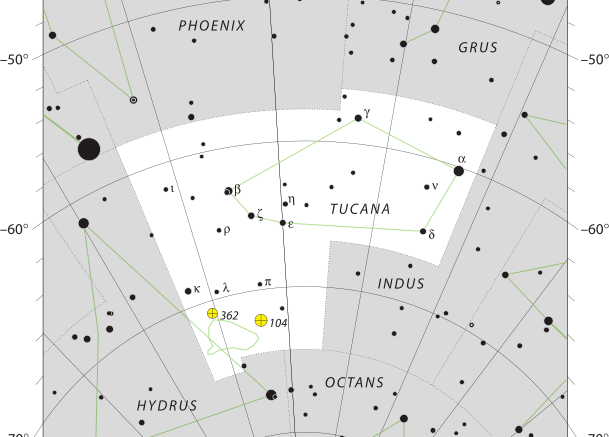Tucana is a constellation of stars in the southern sky, named after the toucan. It is one of twelve constellations conceived in the late sixteenth century by Petrus Plancius from the observations of Pieter Dirkszoon Keyser and Frederick de Houtman. Tucana first appeared on a 35-centimetre-diameter (14 in) celestial globe published in 1598 in Amsterdam by Plancius and Jodocus Hondius and was depicted in Johann Bayer’s star atlas Uranometria of 1603. French explorer and astronomer Nicolas Louis de Lacaille gave its stars Bayer designations in 1756. The constellations Tucana, Grus, Phoenix and Pavo are collectively known as the “Southern Birds”.
Tucana is not a prominent constellation as all of its stars are of 3rd magnitude or fainter, with the brightest star is Alpha Tucanae with an apparent visual magnitude of 2.87. 5 star systems have been found to have exoplanets to date. The constellation contains 47 Tucanae, one of the brightest globular clusters in the sky, and most of the Small Magellanic Cloud.
Covering 295 square degrees, Tucana ranks 48th of the 88 constellations in size. The constellation remains below the horizon at latitudes north of the 30th parallel in the Northern Hemisphere, and is circumpolar at latitudes south of the 50th parallel in the Southern Hemisphere.
| Applicable Information | |
| Visibility In Pacific Northwest | Not Visible In Pacific Northwest |
| Best Times To View | Not Visible In Pacific Northwest |
| Right Ascension | 5h |
| Declination | −65° |
| Area | 295 square degrees |
| Main Stars | 3 |
| Brightest Object | α Tuc |
| Meteor showers | 0 |
| Messier objects | 0 |
| Neighboring Constellations | Grus, Indus, Octans, Hydrus, Eridanus, Phoenix |
History
Tucana is one of the twelve constellations established by the Dutch astronomer Petrus Plancius. To establish Tucana, the observations of the southern sky by the Dutch explorers Pieter Dirkszoon Keyser and Frederick de Houtman. They made these observations when they were on the 1st Dutch trading expedition to the East Indies. The first appearance of Tucana was on a 35 centimeter, 14 inch, diameter celestial globe published in 1598 in Amsterdam by Plancius with Jodocus Hondius.
The first depiction of this constellation in a celestial atlas was in the German cartographer Johann Bayer’s Uranometria of 1603. Both Plancius and Bayer depict it as a toucan. De Houtman included it in his southern star catalogue the same year under the Dutch name Den Indiaenschen Exster, op Indies Lang ghenaemt “the Indian magpie, named Lang in the Indies”,[5] by this meaning a particular bird with a long beak—a hornbill, a bird native to the East Indies.
A 1603 celestial globe by Willem Blaeu depicts it with a casque. It was interpreted on Chinese charts as Niǎohuì “bird’s beak”, and in England as “Brasilian Pye”, while Johannes Kepler and Giovanni Battista Riccioli termed it Anser Americanus “American Goose”, and Caesius as Pica Indica. Tucana and the nearby constellations Phoenix, Grus and Pavo are collectively called the “Southern Birds”.
Stars
Although he depicted Tucana on his chart, Bayer did not assign its stars Bayer designations. French explorer and astronomer Nicolas Louis de Lacaille labelled them Alpha to Rho in 1756, but omitted Omicron and Xi. In 1879.
The layout of the brighter stars of Tucana has been likened to a kite. Within the constellation’s boundaries are around 80 stars brighter than an apparent magnitude of 7.
Discovered in the 1820s by James Dunlop, NGC 362 is a globular cluster in with an apparent magnitude of 6.4. With an orbit that takes it very close to the center of the Milky Way, its stars become visible at 180x magnification through a telescope.
Located at the southern end of Tucana, the Small Magellanic Cloud is a dwarf galaxy that is one of the nearest neighbors to the Milky Way galaxy at a distance of 210,000 light-years. Though it probably formed as a disk shape, tidal forces from the Milky Way have distorted it. Along with the Large Magellanic Cloud, it lies within the Magellanic Stream, a cloud of gas that connects the two galaxies.
NGC 346 is a star-forming region located in the Small Magellanic Cloud. It has an apparent magnitude of 10.3. Open star cluster NGC 299 is located within the Small Magellanic Cloud.
The Tucana Dwarf galaxy, which was discovered in 1990, is a dwarf spheroidal galaxy of type dE5 that is an isolated member of the Local Group.
The barred spiral galaxy NGC 7408 is located 3 degrees northwest of Delta Tucanae, and was initially mistaken for a planetary nebula.
Make sure to check out other articles on the site, including a brief introduction to constellations, other constellation articles, and more!

Be the first to comment on "Tucana"